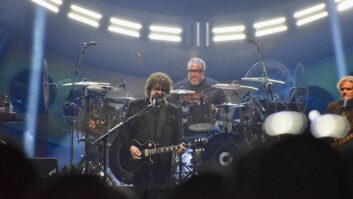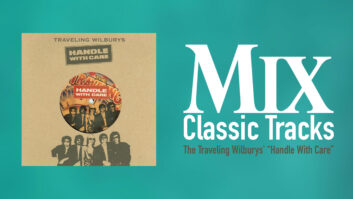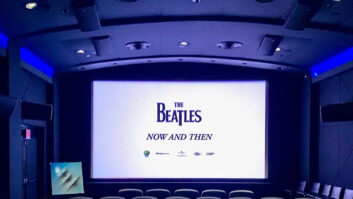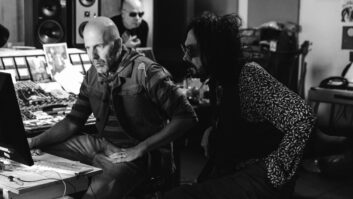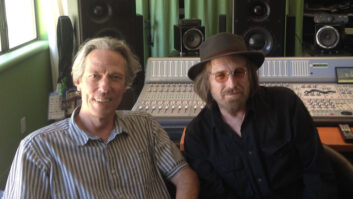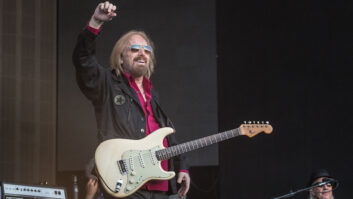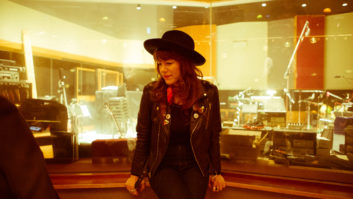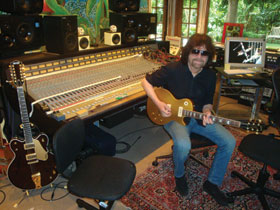
Jeff Lynne
Photo; Matt Hurwitz
Since his introduction to the recording studio in the late 1960s, Jeff Lynne has proven himself a continual innovator. With the formation of Electric Light Orchestra (Lynne, Roy Wood, Bev Bevan) in 1970, he introduced the inclusion of orchestral string players as permanent members of the band, adding a new layer to the pop soundscape. Soon after, the move to Giorgio Moroder’s Musicland studio and collaboration with engineer Reinhold Mack in the mid-’70s culminated in what many consider Lynne’s crowning achievement in recording, ELO’s 1977 double-LP release, Out of the Blue.
Following the breakup of ELO in 1986, Lynne turned heavily to producing other artists, including George Harrison, Dave Edmunds, Paul McCartney, Ringo Starr, Tom Petty, Roy Orbison and a band listed at the top of his recording heroes, The Beatles themselves, for whom he produced the group’s Anthology reunion tracks, “Free As a Bird” and “Real Love” in 1994-95. He was also, of course, a member and co-producer of The Traveling Wilburys, with Harrison, Petty, Orbison and Dylan, releasing two acclaimed discs in 1988 and 1991.
Lynne released one solo album, Armchair Theater in 1990, and 22 years later, on October 9, released a second, Long Wave, a tribute to the classics he heard on the BBC on his father’s long-wave radio in the late ’50s and early ’60s. Released the same day was Mr. Blue Sky: The Very Best of Electric Light Orchestra, for which Lynne has taken a second pass at some of ELO’s biggest hits.
Recording of the two albums took place at Lynne’s Los Angeles home, where he has lived these past 17 years overlooking L.A. and on a good day gaining a view of Catalina. The space has a warm tone with wood-paneled rooms, and Lynne might plug in anywhere. As Joe Walsh, one of Lynne’s most recent collaborators [see Mix August 2012], says in a new documentary (Mr. Blue Sky: The Story of Jeff Lynne and ELO), “Every room in that house is a recording room.”
The control room still reflects Lynne’s analog roots, with a classic 40-channel British Raindirk Symphony LN1 console, a load of EQ modules rescued from his previous Raindirk Series 3 desk, AMS DMX 15-80, S-DMX and RMX-16 digital delays, API 550 and Massenburg 8200 EQ units, API 512b and Brent Averill 1073 and 1272 mic preamps, and plenty of UREI 1176 limiters. Lynne and engineer Steve Jay, with whom he has collaborated for the past five years, record to Pro Tools and mix through the Raindirk, monitoring through Yamaha MSP-10s or Event Opals, as well as larger ATC SCM100 speakers.
Lynne records guitars and vocals in a half-office/half-studio space next to the control room and drums in an extra room filled with spare CDs, box sets and 7-inch vinyl. A very large wood-paneled, high-ceilinged room downstairs, looking much like the interior of a warm hunter’s lodge (and formerly used to store pinball machines by the previous owner), is used for recording piano and string and choir sections, among other things.
For Mix, Lynne reveals his current recording process, as well as that of his pioneering work with ELO, some techniques of which remain in his massive bag of recording tricks.
You’ve had personal recording studios for years. When was your first?
[Points to a Bang & Olufson Beocord 2000 Deluxe reel-to-reel machine in the control room]. That’s my original studio. I got it in 1968. I had a Mellotron in the front room of my mom and dad’s house, and I had that set up, with a record player right next to it in this big cabinet. It’s a 2-track “sound on sound” machine. So you would record on the left track, and then record a mix of that along with, say, a second guitar, onto the right track, and just keep bouncing, adding a vocal or a bass drum. Sometimes I’d bounce 20 times—you’d see through the f***ing tape! It was like Scotch tape in the end. And I could do the best phasing on Earth.
What did you learn from using it?
I learned to experiment. I learned about having sounds together, seeing what piano sounded like with the guitar and how to include the Mellotron.
What do you like about the rooms you use here for recording?
Everything’s made of wood. The big room downstairs has just the right amount of bounce—very soft, not trashy, like a big room can be. The other room, where I record guitars mainly, has just that perfect ratio of room and guitar, like the old BB King kind of blues sound. Dry, but slightly wet. No reverb. I never use any reverb. And my drum room, which is like a storage cupboard—I have some great fun recording in here. You’ll see, I’ve got tielines in each room that lead back to the control room, so there’s no cables running down the halls.

On the two new albums, you play everything yourself. Do you miss having a band of guys around to play with?
No, not really. Don’t forget, when I first started recording, with the B & O, I was on my own. I always record by myself, which I love. I love playing every instrument—that’s my favorite thing, just making a whole, big landscape of racket, with me doing it all. If we’d record everything live, at once, I could never get the separation I wanted, and I could never concentrate enough on the bits that were really important. When you get those bits done early on, and they’re tight and just right, it’s much nicer to play to, to add all the guitars, pianos, keyboards and the harmonies. Once it’s solid, it’s just that much more fun to play.
Walk us through how you build a track.
I’ll start with a click track, which I’ll play to with a hi-hat for about 20 seconds, recording a really good groove. Then I’ll use the click to build up the tracks. I’ll put the snare on, and then tom-tom fills and snare fills. I can play a full rhythm track—I’ve been drumming since I was 13; I play on a Gretsch kit now that I got during the Wilburys sessions—but not necessarily great. So I prefer to build it up, with lots of assistance from Steve and the computer, and just layer it.
Nearly all the time now, I’ll also use a big fat bass drum—a 28-inch Ludwig from 1941 that belongs to Steve. You can cut the room decay down to different lengths. So on some really slow songs, you can have it quite long. Or if it’s a fast song, like “Beyond the Sea” on Long Wave, you gotta pull it in a bit, because otherwise, it’s just one big BOOMBOOM-BOOMBOOM. After the bass drum is in place, I’ll put the bass on, real punchy, dead on, on the note. Then I’ll put the guitar rhythm. From there, I have a foundation to work from.
One of the hallmarks of any great Jeff Lynne recording is the drum sound. How do you create that?
There’s a certain sound that I can hear in my head that I can usually create, depending on the room we’re in. I can always get it in here because Steve knows how to get me the old-fashioned drum sound that I love in that room—a little bit of room on it, and plenty of separation. But a big part of it is I move the overheads out about 10 feet. I don’t like close-up mics. I don’t like the clickiness of them. I especially don’t like a mic under the snare, that little Shure—I hate that sound. It doesn’t even sound like a drum.
This sound really goes back to even the earliest ELO days.
One of the things I do comes from the fact that I couldn’t get enough separation when I would record Bev’s drums. So I used to get him to double-track the snare drum and some of the tom-toms in a room, on their own. So you’d pick up that, along with just the room sound of those drums, which you can then turn up separately in the mix of the kit. It was a much better sound, because the room sound of those drums doesn’t bleed onto the bass drum and everything else. I did that from Day One—4-track the snare drum and the tom-tom. That is the drum sound, really. That’s all it is.
On Mr. Blue Sky, you match the signature sound of “Don’t Bring Me Down” perfectly.
That’s basically a snare that’s just crushed to death by a UREI [1176]. That’s as flat as I could have it without it blowing up or becoming a fuzz box. That’s how I did it in the first place, and I did the same method on the new version. On the original record, that was actually a drum loop from a different song. I just took two tracks of drumming—bass drum and snare, with a bit of leakage on the hi-hat—put it on the 2-track machine and did the old trick, wound it round a mic stand and my old pencil. I think it was two bars long. Recorded that onto the 24-track, and then I was ready to go.
Believe it or not, I think that had eight pianos on it, all doing the same note. God knows what I was expecting to happen. It just gets eight times louder! If you turn it down, it’s still only one piano. It doesn’t track like a guitar [recorded with multiple passes], because a guitar bends a bit. You can slightly knock it out of tune, and you get this big chorus effect. A piano doesn’t do that, of course, until you bang it out of tune.
Do you miss tape?
I don’t miss anything about tape, except the fact that you can tie your plants up with it. [Laughs.]

When did you first get introduced to Pro Tools?
Probably about 14 years ago. I didn’t like it when it was new; it was very low-bandwidth, it sounded brittle and gray, no color to it. Gradually, over the years, the sampling rates got better.
What do you like about working in Pro Tools vs. analog recording?
I love everything about Pro Tools. There were things that sometimes would take a week to do that we can now do in half an hour. It’s so much better, and there’s no moving parts. There’s 10 different ways to get the same sound. I just think it’s super duper.
And you can see everything you’re doing. Who’d have thought you’d end up looking at what you’re recording? You can see where the hit is. In the old days, on tape, you wouldn’t have a clue exactly where a beat was while editing. You just had to get it right, and then, if you were wrong, you had to do it again and again. You can still hear edits in some of the old ELO tracks, when we were recording on tape. Now it’s all smooth.
How did you do basic tracking with ELO?
When I had the band, I’d always start out with piano, bass, guitar and drums—live. And I always used to tell them, “Don’t worry, you won’t hear any of this,” because of all the overdubbing! [Laughs.] And that goes back to what I was saying about recording by myself. When I would record with a band, it was four guys having to get it right, each playing in their own time, trying to get it right all at once at the same time. Now you can have as many goes as you like, and then still tighten it up if you want. If you don’t want anything wrong, you don’t have to have anything wrong. Now you can do it and there’s nothing wrong. I love it.
Do you find you produce songs in your head prior to recording, particularly in the days of complex ELO recordings?
Yeah, I used to think about sounds a lot. There are certain sounds that are just built into me.
I imagine it was great fun for you to create those sounds, as well.
Yeah, it was always fun, because I was using stuff that I never dreamed of using, like choirs. 20 people in a choir—that’s quite an amazing thing to use, if you’ve never done it. And it does certainly add a completely other dimension to something. Same for big string sections, like 30- or 40-piece. It’s funny, at the start, it used to be, “Oh, a string day tomorrow!” with four sessions of strings. But by about the sixth album, it was, like, “Ugh, string day tomorrow—f***. We’re gonna have to do that all day.” Cause by then, I just wanted to simplify it.
The production on Long Wave is decidedly simple.
It’s because the songs are brilliant. You don’t need much to make ‘em work. They’re written by proper geniuses, like Rogers and Hammerstein—absolutely brilliant people. When I was a kid, I didn’t get it at all. My dad would say, “Oh, this is Richard Rogers,” and I’d go, “How? Why? I don’t understand it. It’s just a big load of grownup stuff. What does it mean?” Until I tried listening to it again a few years ago. And I thought, “I’ll have a go at one of these buggers and see if I can make sense of it now and do it.”
How did you approach them?
To learn these songs, I just sat there, playing a guitar part, listening 100 times, tunneling in the bits I needed to learn. The way I’ve recorded them, I’ve stripped them all of their original flowery arrangements that were very good in the day but not really suitable for the way I wanted to do it, which was more punch, make ’em electric. We rebuilt these songs onto my own track.
Your vocal performance, then, becomes so much more important, because it’s really all about the melody and the emotion with songs like these.
Exactly. And that’s why I really had to try really, really hard to get them right. I’d do 10 takes sometimes ‘cause I still wasn’t sure that I’d got everything covered. It was daunting trying to sing any of them. I’d come in to sing it, and it was, like, “Oh, my God. Oh, here we go… “
It’s some of your best singing ever. Particularly challenging, I would imagine, was Roy Orbison’s “Running Scared.” Did you find that, having known him and sung with him, you were able to infuse your performance with some of his heart or intonation?
That’s a really difficult question. I’d listened to him, since I was 13 or 14. It’s like some kind of god…that voice. He’s just…I don’t know, ridiculous. I mean, how can anybody sing like that? It’s so pure and marvelous and emotive. Everything about it just sensational, your hair stands up on end.
In the ELO days, how would you map out all of those interesting lead vocal and background parts, which are so much fun to listen to?
Well, kind of backwards to how most people would do it. I didn’t have any words to any of those ELO songs until the last couple of days, until I had to mix ‘em. I’d got bits of ideas for words, but I never sat down and wrote them. I was too busy doing the music. Lyrics were always the big chore. I’d be, like, “Ugh, I’ve gotta do ’em tomorrow.” I’ve got the tune in the back of my mind, which I could rely on in between doing the rhythm track and finishing all the overdubs, before I did my vocal. For my lead vocal recording, I usually modified the tune to work best with the backing track we’d done. And that sometimes made it difficult to do the backgrounds, because I hadn’t actually made the words up yet. So I couldn’t commit myself if they had words in them until I’d done the vocal.
On tracks like “Mr. Blue Sky,” you always had so many wonderful miscellaneous vocal bits thrown in, as well.
“Mr. Blue Sky” had a lot of stuff going on, little instances popping up. Back then, you could fit ’em in between, where there was an empty part on one section. The engineer, Mack, would say, “You can have four tracks there, just on that bit.” Those little pieces popping up—that is the best fun. I love doing harmonies; it’s my favorite thing to do.
How has your recording experience evolved since ELO?
I had a year off, after I disbanded ELO the first time, and I just played on my desk at home, with me as the engineer. I learned tons about EQ and echo and AMS and stuff. So when I started work with George [Harrison], the engineer, Richard Dodd, knew I was well aware of all that stuff. What I’m good at is EQ, and I like certain effects that I always use, though there are certain ones that I like to experiment with. I have here all the EQ modules from my old 16-track Raindirk desk, because the EQ on them is really, really powerful. It’s got a tremendous sweeping ability. You can sweep through certain frequencies on an electric guitar, and it makes it sound like a slide. I used it twice on Long Wave—on “Love Is a Many Splendored Thing” and “Smile.” It sounds like you’re playing some weird instrument, but it’s actually just that. Oh, shut up! Now I’ve told ya—secret’s out. [Laughs.]
You record dry? I notice you’ve got a nice collection of AMS units.
Everything’s recorded dry, yeah. I love the AMS, even though it’s digital. It’s 30 years old, and it’s so easy to use. It’s just the best gadget or box I’ve ever known. Very rarely use echo on anything, but, if I do, probably would be on voice, just as an effect. And I never use reverb, except as an effect on the end of something.
How did the Mr. Blue Sky album come about?
I heard “Mr. Blue Sky” playing once, and I thought, “I thought it was better than that.” But it obviously wasn’t, not the way I had always heard it in my head. So I started with that one, to see what it would be like. I played it for my manager and a lot of other people, and they all went, “Whoa, you should do more.” So I tried “Evil Woman,” and then I tried “Strange Magic.” And I thought, ”Just keep going, then.” And I enjoyed doing them.
My goal here really wasn’t just trying to reproduce the original sound. I was also trying to improve on the overall sound. The guitar sound, the piano sound, the drum sound—trying to improve all the bits that make up the whole. That’s what I aimed for.
What was the best part of returning to these songs for a second spin? What did you learn from them?
I learned that even though I’d done quite a few albums up to then, I still needed to learn as much as I needed to learn. No song is ever the same as another, when you’re recording them. You can’t beat recording. As far as I’m concerned, it’s as much fun as you can ever have.
